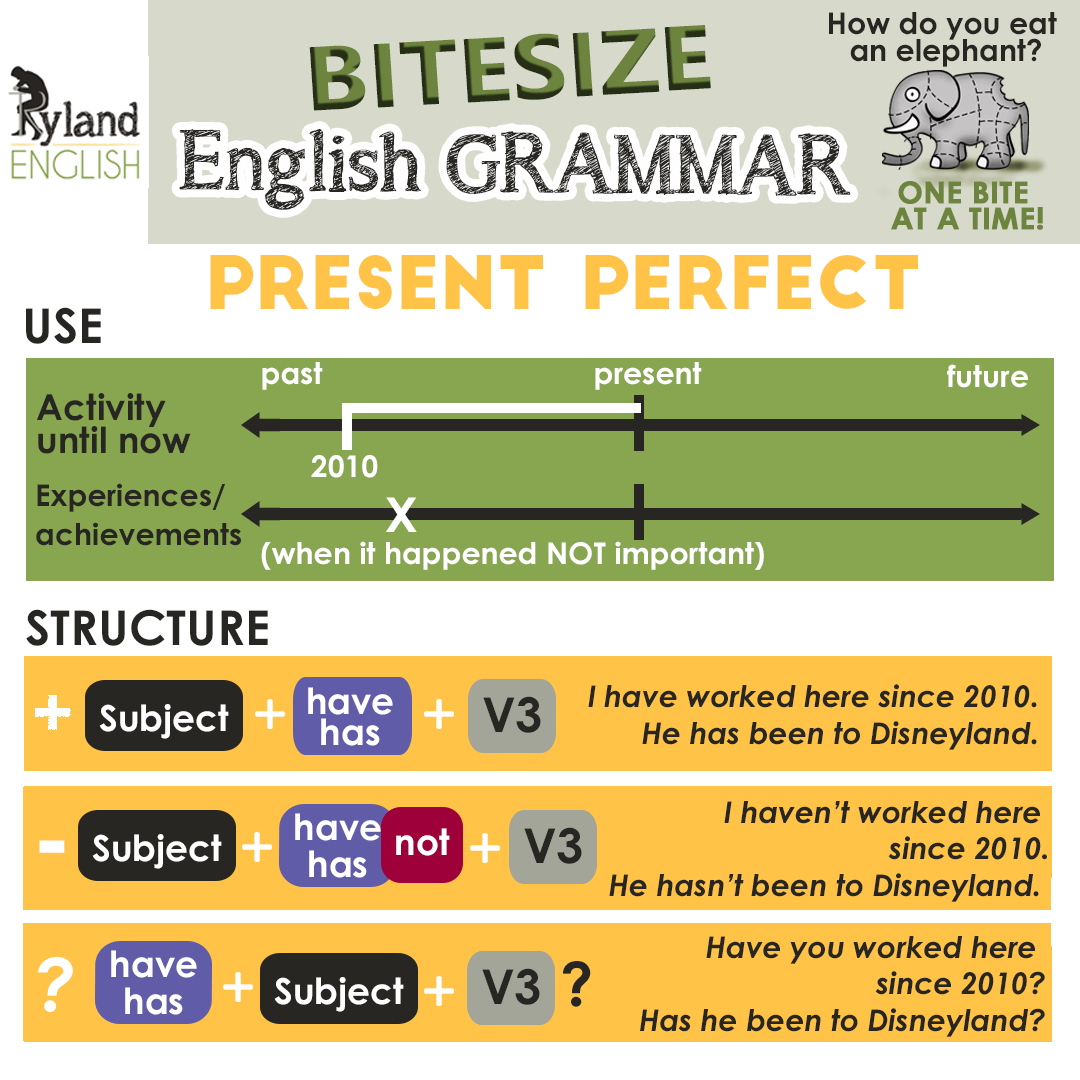
Verb tenses… hmmm… the least exciting of all grammar topics. At least to me!!
So let’s try and make it a bit more interesting by exploring ways to use it in context.
In real life, English native speakers do not consider what tense they need to use, they just know!
To help you remember we will explore when and how to use them… Ready?
The PRESENT PERFECT can be complicated to learn because it does not exist as a verb tense in many languages. So any efforts to translate it are difficult. Even more complicated is the fact that it is used to talk about the past! I get it, it doesn’t make sense, I know!!
But don’t fear, it is less confusing than it sounds. It is a tense we use most often to talk about past events that have a strong connection to the present, or for activities and states that are ongoing or unfinished in the present. Since and for are often used to tell us how long things have been happening.
The most important thing to remember is that when you want to be precise about the timing of an event you use the PAST SIMPLE, when it does not matter when it happened, what is important is that it did happen, you use the PRESENT PERFECT…. get it?
Warning!
in 🇺🇸 English, for some of these situations, they might use the PAST SIMPLE instead!!
How to use the PRESENT PERFECT to talk about FINISHED ACTIONS…
To talk about experiences in our past, regardless of when they happened. Adverbs of time like (e.g. never, ever, etc.) are often used.
I have seen the northern lights.
He has never played football for a premier league team.
Have they ever eaten in a Chinese restaurant?
To talk about changes.
I have finished my homework!
I haven’t seen that movie yet.
Has he left the company?
To talk about the present result of things that happened in the past. The result is the focus of what we are saying because it is still true, important or relevant now.
I‘ve lost my keys so I can’t get into the house.
She can’t do her homework. Dave hasn’t fixed her laptop.
Have you read the report? We need to present it now!
Or to give relevant news.
The Queen has given a speech today.
They’ve won the cup!
How to use the PRESENT PERFECT to talk about UNFINISHED ACTIONS…
To talk about something that started in the past and continues in the present. Words of ‘unfinished time‘ are often used (e.g. this week, today, since, recently, for, etc.).
I have taught in this school for 20 years.
She hasn’t visited London recently.
Have they worked here since 2010?
We often use been and gone in their V3 form. Been to talk about a person that has visited a place and come back. Gone to say they haven’t come back.
I have been to New York [but I now live in London].
Where is Jane? She has gone to Italy for the weekend.
HOW TO PUT IT TOGETHER TO MAKE SENTENCES?
The PRESENT PERFECT is basically made by using have or has [which is what makes it ‘perfect’] and the past participle [V3] form of the verb describing the action or event.
Affirmative sentences
Warning! ‘have’ is used for all except the 3rd person [he, she, it]. For the 3rd person we use ‘has’.
I have visited my sister in Lisbon.
She hasn’t arrived yet.
They have missed the train!
For sentences that are ‘positive‘ or affirmative, you can use have or has and the V3 form of a regular verb, which is done by adding ‘-ed’ at the end of the base form. Irregular verbs have different spellings for the V3 form so you will have to learn them!

Negative sentences
For sentences that are ‘negative‘ you use the same components, have/has and V3, but you have to add the ‘not’ after the auxiliary have/has.

Remember;
‘have not’ = ‘haven’t’
‘has not’ = ‘hasn’t’
Questions
For questions you also use have/has as the auxiliary verb, but you must swap it 🔄 with the person/entity responsible for the action [the subject].

To make a negative question simply add a ‘not’ after have/has.
Haven’t you been to New York?
Hasn’t she seen this movie yet?
TOP TIPS!!!
REMEMBER!! You can contract Subject + have/has…. but for the 3rd person it looks just like contracting the verb ‘to be’ 😱! Be aware of this!
‘I have’ = I’ve
‘you have’ = you’ve
‘he has’ = he’s
‘she has’ = she’s
‘it has’ = it’s
‘we have’ = we’ve
‘you have’ = you’ve
‘they have’ = they’ve
